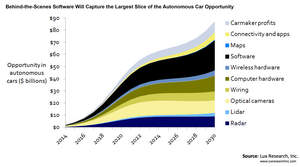BOSTON, MA--(Marketwired - May 20, 2014) - Carmakers and technology developers building self-driving cars will create an $87 billion opportunity in 2030, with software emerging as the biggest winner, even though a fully autonomous driverless car will remain elusive, according to Lux Research.
Automobiles with relatively modest "Level 2" features such as adaptive cruise control, lane departure warning, and collision avoidance braking, will be the mainstay, accounting for 92% of autonomous vehicles in 2030. More advanced "Level 3" cars using high-resolution special maps, demonstrated by Google and Mercedes-Benz, will gain only an 8% share while no fully autonomous "Level 4" car will hit the market.
"Today the autonomous vehicle value chain is already starting to take root, and it involves many players new to the industry," said Cosmin Laslau, Lux Research Analyst and the lead author of the report titled, "Set Autopilot for Profits: Capitalizing on the $87 Billion Self-driving Car Opportunity."
"Sensor hardware specialists like Velodyne Lidar are developing products with unprecedented resolution, software and big-data powerhouses like IBM and Google are striking up partnerships, and even mapping and connectivity experts like Nokia and Cisco are throwing their hats into the ring," he added.
Lux Research analysts evaluated the technologies that shape the self-driving car. Among their findings:
- China will overtake U.S. and Europe. The opportunity in autonomous vehicles will initially be led by the United States and Europe, but China will grow rapidly to claim a 35% share of the 120 million cars sold in 2030, accounting for revenues of $24 billion, against $21 billion for the U.S. market and $20 billion for Europe.
- Software will be competitive differentiator. The software opportunity in autonomous cars will grow rapidly from $0.5 billion today to $10 billion in 2020 and $25 billion in 2030, offering software powerhouses such as Google and IBM a lucrative opportunity. For automakers, varying software will be a key competitive differentiator as well as a crucial safety tool.
- True autonomy remains elusive. In spite of the tremendous hype around driverless vehicles, a vehicle that can truly drive itself in all conditions will not be on the road by 2030 in the likely scenario. In the most optimistic scenario, a technical breakthrough will enable a gradual roll out of "Level 4" cars, resulting in just over 250,000 units sold in 2030.
The report, titled "Set Autopilot for Profits: Capitalizing on the $87 Billion Self-driving Car Opportunity," is part of the Lux Research Autonomous Systems 2.0 Intelligence service.
About Lux Research
Lux Research provides strategic advice and ongoing intelligence for emerging technologies. Leaders in business, finance and government rely on us to help them make informed strategic decisions. Through our unique research approach focused on primary research and our extensive global network, we deliver insight, connections and competitive advantage to our clients. Visit www.luxresearchinc.com for more information.
Contact Information:
Contact:
Carole Jacques
Lux Research, Inc.
617-502-5314
carole.jacques@luxresearchinc.com
